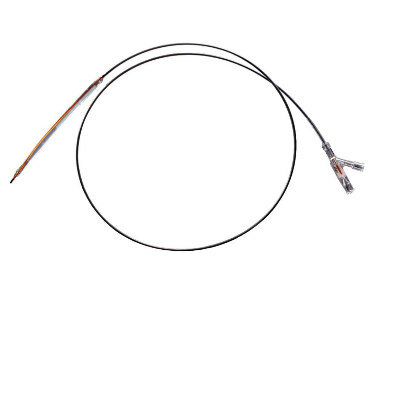ECG Helps Predict Defibrillator Mortality Benefit
|
By HospiMedica International staff writers Posted on 18 Sep 2019 |
A new study suggests an electrocardiogram (ECG) that measures periodic repolarization dynamics (PRD) can help identify patients most likely to benefit from an implantable cardioverter defibrillator (ICD).
Researchers at Munich Technical University (TUM; Germany), Ludwig-Maximilians-Universität (LMU; Munich, Germany), and University Medical Center Göttingen (Germany) conducted a prospective study to examine if PRD, a novel marker of sympathetic-activity-associated repolarization instability, could be used to identify electrically vulnerable patients who would benefit from prophylactic implantation of ICDs.
To do so, they tracked 1,371 patients who met the current criteria for an ICD between May 12, 2014, and September 7, 2018. Of the study population, 968 actually underwent the procedure, while the other 403 patients did not receive an ICD. PRD from 24-hour Holter recordings were assessed blindly in patients the day before ICD implantation, or on the day of study enrolment in patients who were conservatively managed. The primary endpoint was all-cause mortality.
The results showed that during follow-up, 14% of patients died in the ICD group and 16% patients died in the control group; a 43% reduction in mortality in the ICD group was identified, when compared to patients in the control group. PRD significantly predicted the treatment effect of ICDs on mortality (43%), with benefits associated with implantation greater in patients with PRD of 75 degrees or higher (75%) than in those with PRD values below 7.5 degrees (31%). The study was published on September 1, 2019, in The Lancet.
“PRD could become an important decision making tool for physicians. With the additional information, patients who would probably not benefit from a defibrillator could be spared the risk of an implant. Instead, we could focus on those whose lives would likely be extended by the device,” said study co-author Professor Georg Schmidt, MD, head of the Biosignal Processing Working Group at TUM. “The results will first have to be confirmed in further studies, however, before they can be included in medical treatment guidelines.”
PRD refers to low-frequency (≤0.1Hz) modulations of cardiac repolarization instability. Physiological and experimental studies have indicated that PRD correlates with efferent sympathetic nerve activity, which clusters in low-frequency bursts and increases by physiological provocations that lead to enhancement of sympathetic activity, whereas it is suppressed by pharmacological b-blockade. Increased PRD under resting conditions is a strong predictor of mortality in post myocardial infarction patients, particularly in those with a preserved left ventricular ejection fraction (LVEF) higher than 35%.
Related Links:
Munich Technical University
Ludwig-Maximilians-Universität
University Medical Center Göttingen
Researchers at Munich Technical University (TUM; Germany), Ludwig-Maximilians-Universität (LMU; Munich, Germany), and University Medical Center Göttingen (Germany) conducted a prospective study to examine if PRD, a novel marker of sympathetic-activity-associated repolarization instability, could be used to identify electrically vulnerable patients who would benefit from prophylactic implantation of ICDs.
To do so, they tracked 1,371 patients who met the current criteria for an ICD between May 12, 2014, and September 7, 2018. Of the study population, 968 actually underwent the procedure, while the other 403 patients did not receive an ICD. PRD from 24-hour Holter recordings were assessed blindly in patients the day before ICD implantation, or on the day of study enrolment in patients who were conservatively managed. The primary endpoint was all-cause mortality.
The results showed that during follow-up, 14% of patients died in the ICD group and 16% patients died in the control group; a 43% reduction in mortality in the ICD group was identified, when compared to patients in the control group. PRD significantly predicted the treatment effect of ICDs on mortality (43%), with benefits associated with implantation greater in patients with PRD of 75 degrees or higher (75%) than in those with PRD values below 7.5 degrees (31%). The study was published on September 1, 2019, in The Lancet.
“PRD could become an important decision making tool for physicians. With the additional information, patients who would probably not benefit from a defibrillator could be spared the risk of an implant. Instead, we could focus on those whose lives would likely be extended by the device,” said study co-author Professor Georg Schmidt, MD, head of the Biosignal Processing Working Group at TUM. “The results will first have to be confirmed in further studies, however, before they can be included in medical treatment guidelines.”
PRD refers to low-frequency (≤0.1Hz) modulations of cardiac repolarization instability. Physiological and experimental studies have indicated that PRD correlates with efferent sympathetic nerve activity, which clusters in low-frequency bursts and increases by physiological provocations that lead to enhancement of sympathetic activity, whereas it is suppressed by pharmacological b-blockade. Increased PRD under resting conditions is a strong predictor of mortality in post myocardial infarction patients, particularly in those with a preserved left ventricular ejection fraction (LVEF) higher than 35%.
Related Links:
Munich Technical University
Ludwig-Maximilians-Universität
University Medical Center Göttingen
Latest Critical Care News
- 'Universal' Kidney to Match Any Blood Type
- Light-Based Technology to Measure Brain Blood Flow Could Diagnose Stroke and TBI
- AI Heart Attack Risk Assessment Tool Outperforms Existing Methods
- Smartphone Imaging System Enables Early Oral Cancer Detection
- Swallowable Pill-Sized Bioprinter Treats GI Tract Injuries

- Personalized Brain “Pacemakers” Could Help Patients with Hard-To-Treat Epilepsy
- Microscopic DNA Flower Robots to Enable Precision Medicine Delivery
- Origami Robots to Deliver Medicine Less Invasively and More Effectively
- Improved Cough-Detection Technology Aids Health Monitoring
- AI Identifies Children in ER Likely to Develop Sepsis Within 48 Hours
- New Radiofrequency Therapy Slows Glioblastoma Growth
- Battery-Free Wireless Multi-Sensing Platform Revolutionizes Pressure Injury Detection
- Multimodal AI to Revolutionize Cardiovascular Disease Diagnosis and Treatment
- AI System Reveals Hidden Diagnostic Patterns in Electronic Health Records
- Highly Sensitive On-Skin Sensing Monitor Detects Vitamin B6 and Glucose in Sweat
- Artificial Intelligence Revolutionizing Pediatric Anesthesia Management
Channels
Surgical Techniques
view channel
Minimally Invasive Endoscopic Surgery Improves Severe Stroke Outcomes
Intracerebral hemorrhage, a type of stroke caused by bleeding deep within the brain, remains one of the most challenging neurological emergencies to treat. Accounting for about 15% of all strokes, it carries... Read more
Novel Glue Prevents Complications After Breast Cancer Surgery
Seroma and prolonged lymphorrhea are among the most common complications following axillary lymphadenectomy in breast cancer patients. These postoperative issues can delay recovery and postpone the start... Read morePatient Care
view channel
Revolutionary Automatic IV-Line Flushing Device to Enhance Infusion Care
More than 80% of in-hospital patients receive intravenous (IV) therapy. Every dose of IV medicine delivered in a small volume (<250 mL) infusion bag should be followed by subsequent flushing to ensure... Read more
VR Training Tool Combats Contamination of Portable Medical Equipment
Healthcare-associated infections (HAIs) impact one in every 31 patients, cause nearly 100,000 deaths each year, and cost USD 28.4 billion in direct medical expenses. Notably, up to 75% of these infections... Read more
Portable Biosensor Platform to Reduce Hospital-Acquired Infections
Approximately 4 million patients in the European Union acquire healthcare-associated infections (HAIs) or nosocomial infections each year, with around 37,000 deaths directly resulting from these infections,... Read moreFirst-Of-Its-Kind Portable Germicidal Light Technology Disinfects High-Touch Clinical Surfaces in Seconds
Reducing healthcare-acquired infections (HAIs) remains a pressing issue within global healthcare systems. In the United States alone, 1.7 million patients contract HAIs annually, leading to approximately... Read moreHealth IT
view channel
Printable Molecule-Selective Nanoparticles Enable Mass Production of Wearable Biosensors
The future of medicine is likely to focus on the personalization of healthcare—understanding exactly what an individual requires and delivering the appropriate combination of nutrients, metabolites, and... Read moreBusiness
view channel
Philips and Masimo Partner to Advance Patient Monitoring Measurement Technologies
Royal Philips (Amsterdam, Netherlands) and Masimo (Irvine, California, USA) have renewed their multi-year strategic collaboration, combining Philips’ expertise in patient monitoring with Masimo’s noninvasive... Read more
B. Braun Acquires Digital Microsurgery Company True Digital Surgery
The high-end microsurgery market in neurosurgery, spine, and ENT is undergoing a significant transformation. Traditional analog microscopes are giving way to digital exoscopes, which provide improved visualization,... Read more
CMEF 2025 to Promote Holistic and High-Quality Development of Medical and Health Industry
The 92nd China International Medical Equipment Fair (CMEF 2025) Autumn Exhibition is scheduled to be held from September 26 to 29 at the China Import and Export Fair Complex (Canton Fair Complex) in Guangzhou.... Read more







.jpg)






